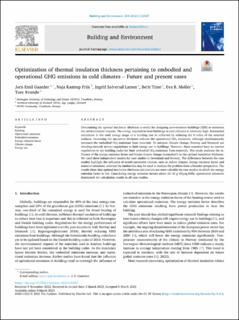| dc.contributor.author | Gaarder, Jørn Emil | |
| dc.contributor.author | Friis, Naja Kastrup | |
| dc.contributor.author | Larsen, Ingrid Sølverud | |
| dc.contributor.author | Time, Berit | |
| dc.contributor.author | Møller, Eva B. | |
| dc.contributor.author | Kvande, Tore | |
| dc.date.accessioned | 2023-03-21T13:38:01Z | |
| dc.date.available | 2023-03-21T13:38:01Z | |
| dc.date.created | 2023-03-20T14:58:14Z | |
| dc.date.issued | 2023 | |
| dc.identifier.issn | 0360-1323 | |
| dc.identifier.uri | https://hdl.handle.net/11250/3059560 | |
| dc.description.abstract | Determining the optimal insulation thickness is useful for designing zero-emission buildings (ZEB) to minimize the environmental impacts. The energy required to heat buildings in cold climates is relatively high. Substantial reductions in the total energy usage of a building can be achieved by reducing the U-value of the external surfaces. Increasing the insulation thickness reduces the operational CO2 emissions, although simultaneously increases the embodied CO2 emissions from materials. To mitigate climate change, Norway and Denmark are trending towards stricter regulations to limit energy use in buildings. However, these countries have no current regulations in the building codes for limit embodied CO2 emissions from materials. This study analyzes the influence of the energy emission factor and future climate change (scenarios?) on the optimal insulation thickness. We used three independent models for case studies in Greenland and Norway. The differences between the case studies highlight the influence of model parameter choices, such as indoor climate, energy emission factor and material emissions, whereas the similarities may be used to analyze the problem from a broader perspective. The results show that optimal insulation thickness calculations are most valuable for case studies in which the energy emission factor is low. Considering energy emission factors above 25–30 g CO2eq/kWh, operational emissions dominated the calculation results in all case studies. | en_US |
| dc.language.iso | eng | en_US |
| dc.publisher | Elsevier | en_US |
| dc.rights | CC BY 4.0 | * |
| dc.rights.uri | http://creativecommons.org/licenses/by/4.0 | * |
| dc.subject | Building | en_US |
| dc.subject | Operational emissions | en_US |
| dc.subject | Embodied emissions | en_US |
| dc.subject | Energy emission factor | en_US |
| dc.subject | Climate change | en_US |
| dc.subject | Energy use | en_US |
| dc.title | Optimization of thermal insulation thickness pertaining to embodied and operational GHG emissions in cold climates – Future and present cases | en_US |
| dc.title.alternative | Optimization of thermal insulation thickness pertaining to embodied and operational GHG emissions in cold climates – Future and present cases | en_US |
| dc.type | Peer reviewed | en_US |
| dc.type | Journal article | en_US |
| dc.description.version | publishedVersion | en_US |
| dc.rights.holder | © 2023 The authors | en_US |
| dc.subject.nsi | VDP::Teknologi: 500 | en_US |
| dc.source.volume | 234 | en_US |
| dc.source.journal | Building and Environment | en_US |
| dc.identifier.doi | 10.1016/j.buildenv.2023.110187 | |
| dc.identifier.cristin | 2135403 | |
| dc.relation.project | Norges forskningsråd: 237859 | en_US |
| dc.source.articlenumber | 110187 | en_US |
| cristin.ispublished | true | |
| cristin.fulltext | original | |
| cristin.qualitycode | 2 | |

